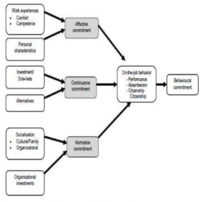Three- Component Model Questionnaire (TCM)
The three-component model of commitment developed by Meyer and Allen (1997) arguably dominates organizational commitment research (Meyer et al., 2002). This model proposes that organizational commitment is experienced by the employee as three simultaneous mindsets encompassing affective, normative, and continuance organizational commitment. Affective Commitment reflects commitment based on emotional ties the employee develops with the organization primarily via positive work experiences. Normative Commitment reflects commitment based on perceived obligation towards the organization, for example rooted in the norms of reciprocity. Continuance Commitment reflects commitment based on the perceived costs, both economic and social, of leaving the organization. This model of commitment has been used by researchers to predict important employee outcomes, including turnover and citizenship behaviors, job performance, absenteeism, and tardiness (Meyer et al., 2002). Meyer and Allen (1997) provide a comprehensive overview of the theoretical lineage of this model.[1]
Meyer and Allen’s Three-Component Model of Organizational Commitment

source: Meyer and Allen(1991)
See Also
Organization
Organizational Commitment
Organizational Commitment Questionnaire (OCQ)
Organization Design
Organizational Agility
Organizational Capability
Organizational Architecture
Organizational Change
Organizational Change Management (OCM)
Organizational Culture
Organizational DNA
Organization Chart
Organizational Absorption
Organizational Configurations
Organizational Development
References
- ↑ Defining the Three-Component Model Questionnaire (TCM)Stephen Jaros
